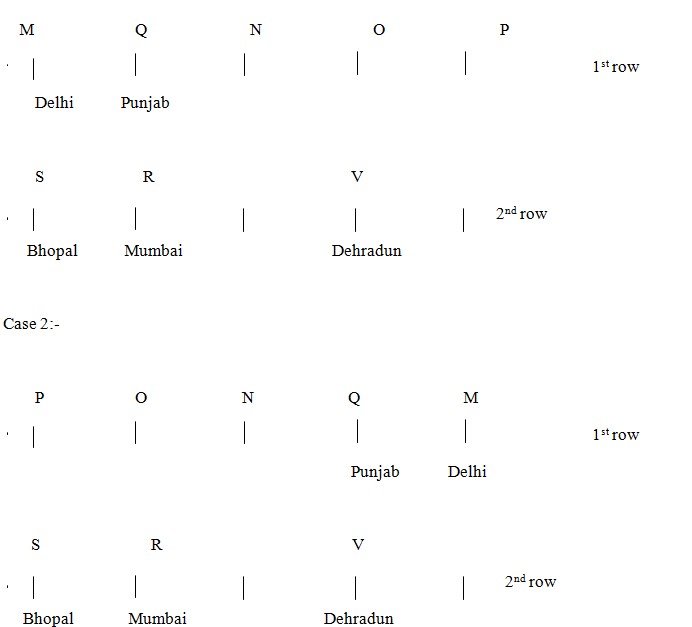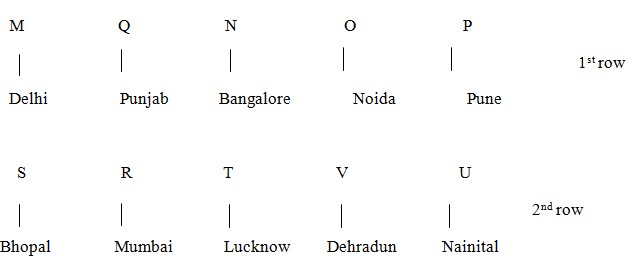Question
Who among the following persons sits on the left end of
both rows? Study the following information carefully to answer the given questions:- There are ten family members M, N, O, P, Q, R, S, T, U, V. They like different cities i.e. Delhi, Bangalore, Mumbai, Bhopal, lucknow, Dehradun, Nainital, Pune, Punjab and Noida but not necessarily in the same the same order. They are sitting in two parallel rows containing five members each, in such a way that there is an equal distance between adjacent persons. In row 1 – M, N, O, P, Q are seated (not necessarily in the same order) and all of them are facing south. In row 2- R, S, T, U, V are seated (not necessarily in the same order) and all of them are facing north. Members of row 1 are sitting ahead (towards north) of the members of row 2. Therefore in the given seating arrangement each member seated in row 2 faces the back of the other member of row 1. All of them have relation with each other. Only one member sits between O’s sister and M’s brother. Neither N nor U’s grandfather sits just opposite to U. S likes Bhopal and N likes neither Delhi nor Noida. Only two members sit between O’s father and U’s father. U’s husband, who likes Dehradun, sits third to the right of U’s uncle. R sits second to the left of U’s husband. M has two sons and one daughter. Q is the grandmother of R and U. P is the brother – in – law of Q. O is the father of R and brother of N. R’s grandfather, who likes Delhi is not an immediate neighbour of N. The member who sits just opposite to U’s brother, who likes Mumbai, sits immediate left of M’s daughter. V is the husband of U and brother of the one, who likes Lucknow. U likes Nainital and Q likes Punjab. O likes neither Pune nor Bangalore. T likes Lucknow. P does not like BangaloreSolution
Now for sitting arrangement – Only one member sits between O’s sister and M’s brother. Only two members sit between O’s father and U’s father. U’s husband, who likes Dehradun, sits third to the right of U’s uncle. R sits second to the left of U’s husband. The member who sits just opposite to U’s brother, who likes Mumbai, sits immediate left of M’s daughter. R’s grandfather, who likes Delhi, is not an immediate neighbour of N. U likes Nainital and Q likes Punjab. From these conditions there will be two cases: Case 1:-  Now Neither N nor U’s grandfather sits just opposite to U. As there will be no place left for U in case 2. So case 2 will be eliminated. From rest U likes Nainital and Q like PUNJAB. O likes neither Pune nor Bangalore. T likes Lucknow. P does not like Bangalore. So the final solution is –
Now Neither N nor U’s grandfather sits just opposite to U. As there will be no place left for U in case 2. So case 2 will be eliminated. From rest U likes Nainital and Q like PUNJAB. O likes neither Pune nor Bangalore. T likes Lucknow. P does not like Bangalore. So the final solution is – 
- A cyclist starts from village 'M' at 8:00 AM towards village 'N' at 20 km/h. A biker starts from 'M' at 9:30 AM in the same direction at 60 km/h. Find the ...
- A boy standing on a hill hears the echo of a shot from a nearby cliff located 2.5 km away, after 28 seconds. Determine the approximate speed at which sound...
It takes 12 hours less to travel from point 'C' to point 'D' at a speed of 50 km/h than it takes to travel the same distance at 20 km/h. If 50% of the d...
The speeds of Car 'A' and Car 'B' are 25 km/hr and 45 km/hr, respectively. If Car 'A' covers a distance that is 36 km shorter tha...
- Ravi started jogging from point X at 12 m/s. 10 seconds later, Sunil began running from the same point in the same direction and managed to catch Ravi in 3...
The speed of a train is 90 km/hr and it takes 16 seconds to cross a man. Find the time taken by train to cross a platform if the ratio of the length of ...
A motor-cycle covers 110 km with a speed of 45 km/hr. find the speed of the motor-cycle for the next 110 km journey so that the average speed of the who...
- 'C' takes 50 minutes more than 'D' to cover 'x' km. If the speed of 'C' and 'D' is 8 km/h and 10 km/h, respectively, find the value of 'x'.
Train P starts from Lucknow to Dehradun at 11:55 am with an average speed of 30 m/s. Train Q starts from Dehradun to Lucknow at 1:35 pm with an average ...
Walking 3/4 of his normal speed, Ravi was 21 minutes late in reaching his office. The usual time took to cover the distance between his home and office ...
Relevant for Exams:


